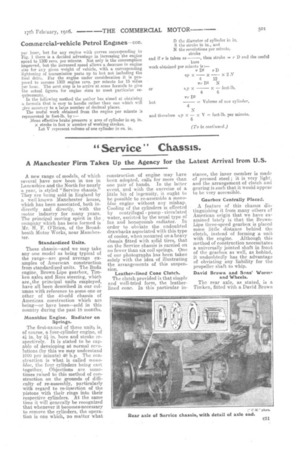" Service " Chassis.
Page 15

Page 16

If you've noticed an error in this article please click here to report it so we can fix it.
A Manchester Firm Takes Up the Agency for the Latest Arrival from U.S.
A new range of models, of which several have now been in use in Lancashire and the North for nearly a year, is styled "Service chassis." They are being sold in England by well-known Manchester house, which has been associated, both in. directly and directly, with the motor industry for many years. The principal moving spirit in the company which has been formed is Mr. H. F. O'Brien, of the Broadheath Motor Works, near Manchester.
Standardized Units.
These chassis—and we may take any one model as being typical of the range—are good average examples of American construction from standardized units. The Buda engine. Brown-Lipe gearbox, Timken axles and Ross steering, which arethe principal units employed, have all been described in our columns with reference to some one or other of the 40-odd chassis of American construction which are being—or have been—sold in this country during the past 18 months.
Monobloc Engine. Radiator on Springs.
The first-named of these units is, of course, a four-cylinder engine, of 4/, in. by 5,1 in. bore and stroke respectively. It is stated to be capable of developing at normal revolutions (by this we may understand 1000 per minute) 40 h.p. The construction is what is called monobloc, the four cylinders being cast together. Objections are sometimes raised to this method of construction on the grounds of difficulty of re-assembly, particularly with regard to re-insertion of the pistons with their rings into their respective cylinders. At the same time it will generally be recognized that whenever it becomes-necessary to remove the cylinders, the operation is one which, no matter what construction of engine may have been adopted, calls for more than one pair of hands. In the latter event, and with the exercise of a little bit of ingenuity, it ought to be possible to re-assemble a monobloc engine without any mishap. Cooling of the cylinders is effected by centrifugal pump circulated water, assisted by the usual type of fan and honeycomb radiator. In order to obviate the undoubted drawbacks avociated with this type of cooler, when mounted on a heavy chassis fitted with solid tires., that on the Service chassis is carried on no fewer than six coil springs. One of our photographs has been taken solely with the idea of illustrating the arrangements of this suspension.
Leather-lined Cone Clutch.
The clutch provided is that simple and well-tried form, the featherlined cone. In this particular in stance, the inner member is made of pressed steel ; it is very light, and the arrangement of clutch and gearing is such that it would appear to be very accessible.
Gearbox Centrally Placed.
A feature of this chassis distinguishing it from many others of American origin that we have examined lately is that the BrownLipe three-speed gearbox is placed some little distance behind the clutch, instead of forming a unit with the engine. Although this method of construction necessitates a universally jointed shaft in front of the gearbox as well, as behind, it undoubtedly has the advantage of obviating any liability for the propeller shaft to whip.
David Brown and Sons' Worm.* and Wheels.
The rear axle, as stated, is a Timken, fitted with a David Brown
overtype worm and wheel. In order to satisfy himself as to the exact meaning of the title "David Brown' as applied to these axles, id also in response to inquiries from one or two possible purchasers of Service machines, Mr. O'Brien has recently been in communication with Messrs. David Brown and Sons, of Huddersfield, the wellknown gear cutting firm, who inform him that all these worms and wheels are actually cut in David Brown. and Sons' works in the United States. It is interesting to note that the brakes on the Service chassis, both of which take effect on the rear-wheel drums, are all compensated and the arrangement is such that the adjustment can very readily be made. The driving reaction of the rear axle takes effect on the rear springs, the top leaves of which also do duty as radius rods.
General.
Other features of the chassis conform in general to those to which we are by now accustomed on American assembled vehicles: The particnla-r model which we examined was for 2i tons gross. For this load the frame appeared to be fairly substantial, and the springing also would seem to be sufficient. The control gear, that is to say, changespeed lever and hand brake lever, are centrally disposed in the chassis; throttle and sparking advance levers are placed on the steering wheel, and an accelerator pedal also is provided.
The complete range of types comprise five different models for loads ranging from 11 ton up to 6 tons., The description given applies in general to the 4-tonner, 2:1-tonner and 4-tonner. There are two larger models for four and six tons, in which the final drive is by means of side chains. We hope to examine these at a later date.




















